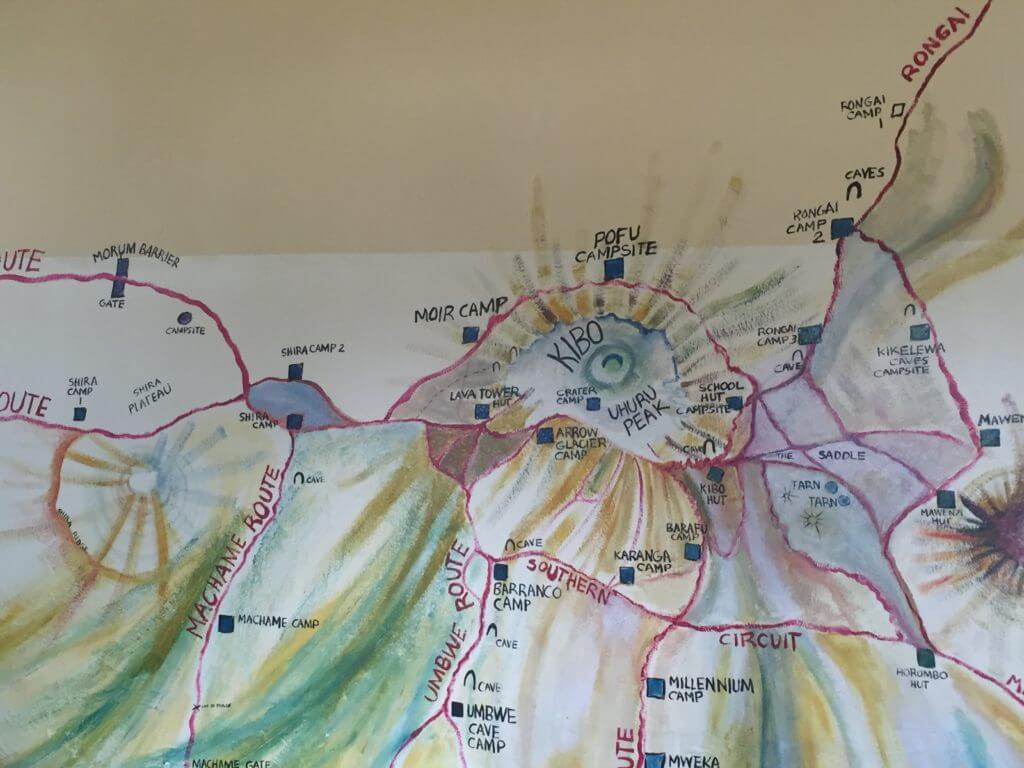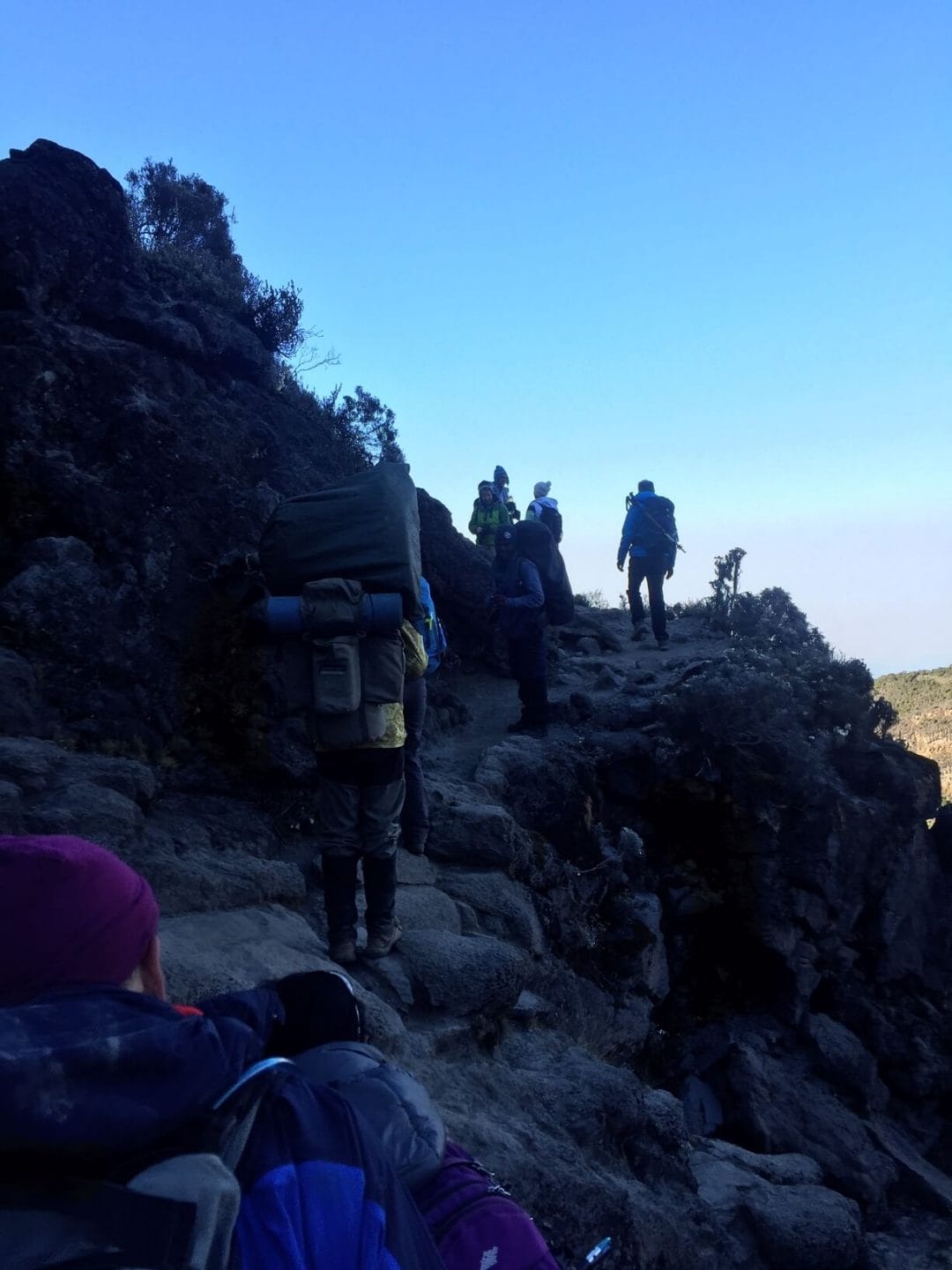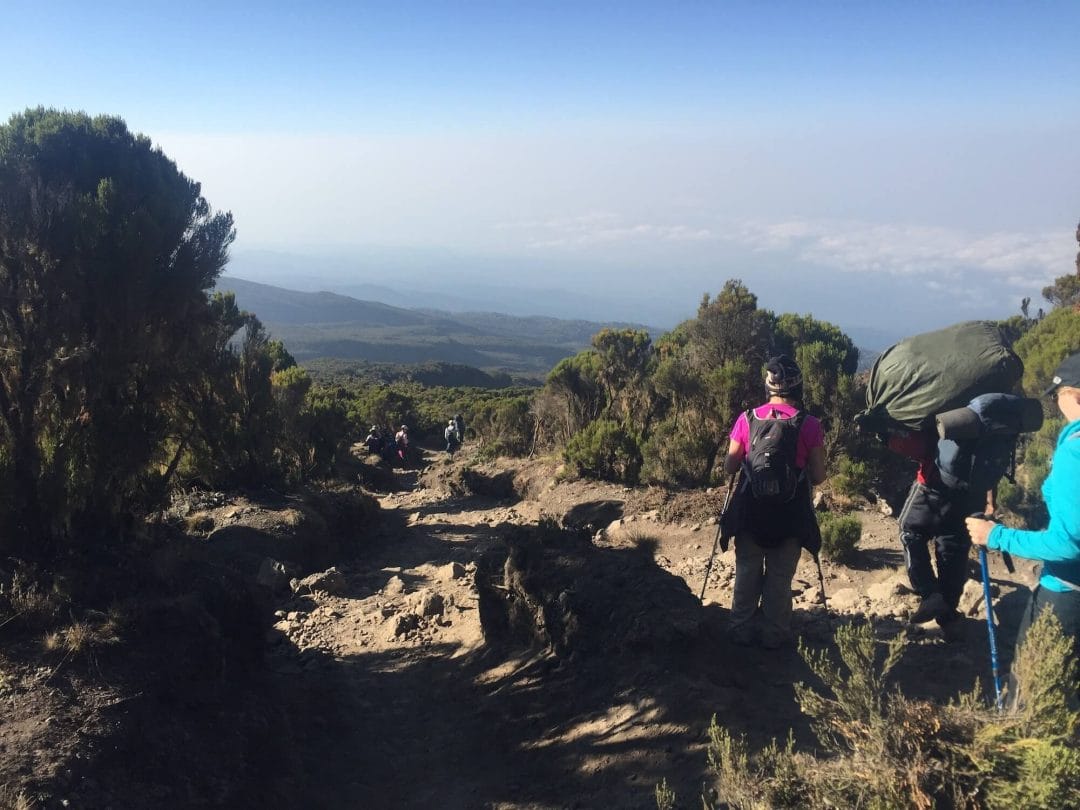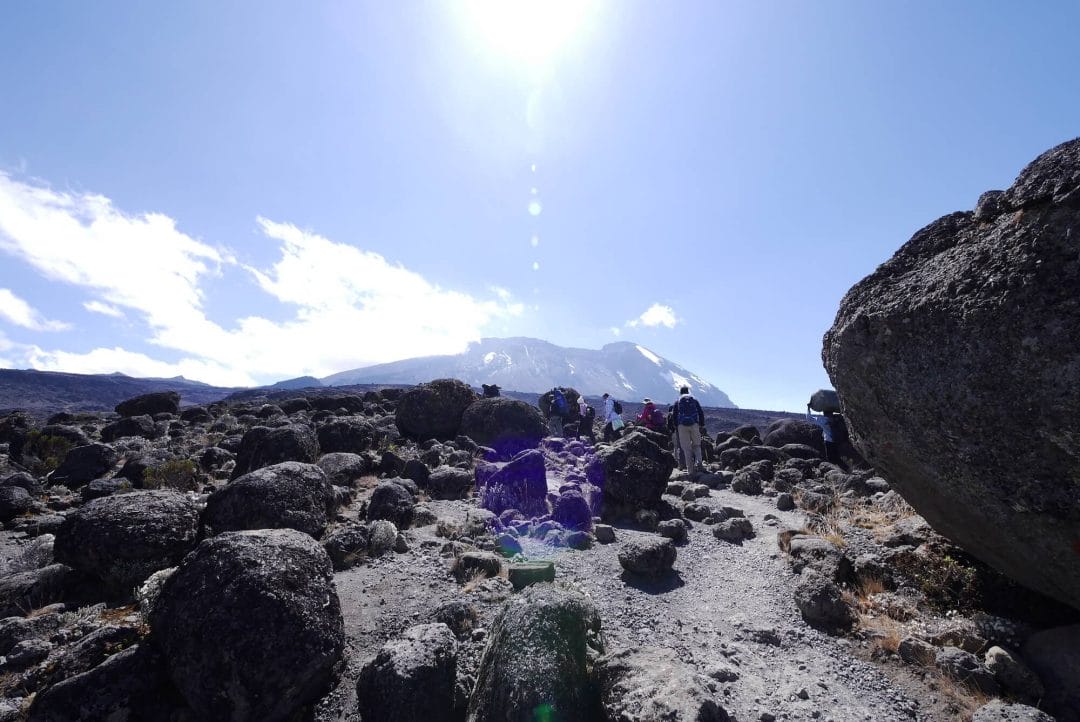Taking on Kilimanjaro is a major decision. It will possibly be one of the more dangerous things you decide to undertake. Deaths are rare but they do happen. How do you prepare for it and how should you deal with the inevitable bumps on the trail that you will encounter? Read on to find out how I dealt with it and learn from some of my mistakes.

Our welcome meeting for the climb took place in a conference room with this rather wonderful map of the circuits.
Preparing For Kilimanjaro – Mental Preparation
Half the challenge of getting to the top will depend on the battle you have with yourself. I booked my tour 9 months before I travelled (although I had been thinking about it much longer) and as the days quickly ticked by I can honestly say that I didn’t really think about the 6 days of pain that awaited. My friends and family kept asking questions but I could only give them so much information. I tried to find out an in depth account of somebody’s time but most blogs are somewhat sketchy on the finer details, that’s why I decided to write my own and it is what inspired this blog. You can read my day to day account of the Machame Route to the summit by using these links
- Day 1 – Machamae Gate To Machame Camp
- Day 2 – Machame Camp To Shira 2 Camp
- Day 3 – Shira 2 Camp To Barranco Camp
- Day 4 – Barranco Camp To Barafu Camp
- Day 5 – Barafu Camp To Stella Point To Uhuru Peak To Barafu Camp To Millennium Camp
- Day 6 – Millennium Camp To Mweka Gate
It may sound easy for me to say this now looking back, but try not to get hung up on the Barranco Wall or the tales of pain that you will come across as people recount summit night or wondering how you will deal with the extreme altitude or the cold. The weather and the altitude are out of your hands. If the Barranco Wall really bothers you, book a tour on a route that doesn’t use it (but I promise its no where near as bad as people make out).

As you can see, fears of the crumbling trail leading up the wall are exaggerated. It is easily passable with some common sense.
Kilimanjaro will test you physically and mentally but you have to remain positive. Don’t let any seed of doubt creep in. I can’t stress the importance of a positive mental attitude in approaching the challenge. There will be moments on the mountain that you wonder if you can or should go on. Almost everyone in your small group will have the same moment at different times. As a group you help each other get through the tough times. Remember you aren’t alone up there.
Preparing For Kilimanjaro – Physical Preparation
It’s a common misconception that you have to be very physically fit to take on the mountain, or the fitter you are the better your chances of dealing with the altitude. I’ll come on to the altitude thing in a bit but I will say that the more physically fit you can be the better your body will have of dealing with the stress of the experience. This has very little to do with altitude. It has everything to do with hiking through rough terrain, sometimes steep if you are not used to walking for kilometers every day.
Physically speaking, hiking Kilimanjaro is quite easy. The pace set by your guides is deliberately slow. It’s frustrating at first but the 4 or 5 days before summit night are as much about preparing your body for the altitude as it is about actually getting up the mountain.
As the days tick by and the altitude gets gradually higher, you will find your pace getting slower and you will make more frequent stops, feeling like your lungs will burst out of your chest. That’s the altitude, not necessarily the physical exertion. How best do you prepare for this when most of us won’t have access to anything approaching even a 5th the height of Kilimanjaro?
I focussed on my cardio which has always been lacking so I knew it could be my Achilles heel. I enjoy racquet sports so I played every opportunity I could. I made a point of getting into a swimming pool and pushing myself. I’m lucky in that I have a fairly physical job so if any overtime arose I volunteered and the steeper it was the better.
I didn’t go into Kilimanjaro with a plan. I kinda winged it but it worked for me. If you play sports, play more often but focus on your cardio and in particular your breathing when you are exercising. In through the nose and out the mouth.
You don’t have to be in peak physical fitness (i’m living proof of that!) Anything you can do in the run up will help you more than you will appreciate when you are going through a tough period on the mountain. If you are close to some mountains or even hills, go for a hike around them. Take a small rucksack weighed down to simulate what you will be carrying with you (every hiker is expected to take a day pack and at least 3 litres of water every morning).
Preparing For Kilimanjaro – The Altitude Problem
There is very little you can do to prepare yourself for altitude unless you live near an accessible mountain that is over 3,500 meters, which is hard to come by even in the Alps.
Nobody can tell you how your body will deal with the altitude. You will only find out when you are at altitude. I had done a couple of high altitude tours before Kilimanjaro so I knew I was good up to 4000 meters but above that was a mystery.

The view from a quiet Stella Point, 5739 meters up, just after 8am and after the longest yet most rewarding night of my life.
If you think you are going to suffer, the longer you spend on the mountain the greater your chances of a successful summit but you have to weigh up the success to cost factor. The licence from the park authority, labour, raw materials and rent of equipment, each day on the mountain will roughly set you back a minimum of US$150-US$200 depending on how many people are in your group.
The most popular trek to the top is the 6 day Machame Trek but there is a longer 7 day trek of the same route. Some companies offer even longer using different routes. The slower you can ascend the better your chances are. Having said that, G Adventures who I use for a lot of my adventure tours, have a success rate of over 90% using the 6 and 7 day Machame treks.
There is very little you can do about how you will deal with the altitude so try to stop worrying about it. Always keep in mind though that if you don’t try you will never know.
Preparing For Kilimanjaro – Equipment
Some of what you need could be included in the cost of your tour. You will need to check the trip notes carefully. As a minimum make sure you either have the following included or you take these with you.
- A good quality sleeping bag
- A good pair of worn in hiking boots
- Capacity to carry 3 litres of water (water bladder or bottles)
- A good sized day pack (30 litres min)
- Thin layers
- A waterproof layer just in case
- A small selection of snacks (chocolate bars, energy bars etc)
- A head lamp or torch
- Hand Sanitiser
- Toilet Paper!
Layering is so important to keeping your core body temperature down with all the physical exertion you will be doing. Take a thermal layer for the summit night, a couple of mid layers, fleece and waterproof outer jacket. The weather on Kilimanjaro is as varied as the landscape, one day I was hiking in shorts and a t-shirt but 90 minutes later I had all my layers on plus my waterproof as we hit the cloud layer and wind. Thin layers are easier to pack in your day pack along with cameras, water, lunch and snacks and they are better at regulating the heat.
A sleeping bag generally isn’t included. A good quality 4 season bag is recommended by most operators but with a week in the mild Serengeti after my climb I opted for a 3 season sleeping bag and was fine without too much hassle. One night was exceptionally cold but a thin layer of thermals and a pair of socks meant I couldn’t tell the difference.
Preparing For Kilimanjaro – Dealing With The Altitude
It’s something that won’t escape you. At some point you will feel the effects. You can’t do much about the route and the pace is deliberately slow, it’s not a route march. The number one way to avoid AMS (Acute Mountain Sickness) is to take your time. This is certainly not the place where you want to save a buck and try and get up there as quick as you can. Any reputable operator will dissuade you from this strategy before you even finish the sentence.
The next best thing while on the mountain is to keep hydrated. That means drinking more water than you ever have or probably will. A minimum of 3 litres in your day pack while trekking plus a top up before you leave camp and again when you arrive at the next camp. Although 3 litres is the recommended average, 4-5 litres or more is generally the norm for climbers. You won’t be expected to buy the water either. Each morning the porters take water from the glacial run off and boil it so it’s safe to drink. You can take purifying tablets with you but they are not necessary.
Starting off in the rainforest water may be the last thing on your mind but from day 2 you will notice the atmosphere gradually getting drier as the oxygen level drops (roughly a tenth for every 1000m gain in height). There are places on the mountain that are technically classed as a desert because they receive so little rainfall. The atmosphere is so dry you sweat very little, instead you lose moisture through convection on the exposed parts of your skin without even realising it.
You will feel thirsty, almost constantly. Listen to your body. Drink little and often. Don’t do what I did and try to avoid the all too often trips to the toilet block by not drinking. That nearly scuppered my chances on the Shira Plateau before we were even half way up the mountain.
Along with copious amounts of water you need to eat a lot of calories. The chefs on the mountain are magicians with the barest of essentials they are given but altitude plays a funny game with our digestive system. I’ve never been faced with so much food yet feel helpless in trying to eat it the higher I got. Even if you don’t feel like eating make sure you have as much as you can stomach. Your body is burning calories just being at altitude and you need all the fuel you can get to keep up with the physical aspect of the climb. It’s not hard, its not fast; its slow and methodical but at the summit your body is keeping you going but it has 40% less oxygen in every breath you take.
Exactly How Dangerous is Kilimanjaro?
A quick check for some historical figures in Wikipedia puts the mortality rate at 0.0136% based on figures provided by the Kilimanjaro Christian Medical Centre in Moshi. Between January 1996 and October 2003 25 people died on the mountain with ages ranging from 29 to 74. Fourteen died from Advanced High Altitude Sickness; 1 of HACE (an edema or fluid on the brain), 5 from HAPE (fluid on the lungs) and 6 with both. The remaining 11 were from a mixture of things ranging from trauma to pneumonia.
While these figures may look alarming it’s important to note the amount of people that take on the mountain yearly. Kilimanjaro is a safe mountain. Thousands of people have summited safely and thousands more will continue to do so because of the excellent care and attention you receive from your tour guides and helpers and the processes in place on the mountain. Not everyone will make it to the summit however. Loss of appetite and problems sleeping are well known symptoms that almost everyone will suffer with at some point but if you feel light headed, nauseous or your limbs ache and the usual tablets have no effect please tell your guides so they can keep a closer eye on you. AMS is entirely avoidable! Listen to your body, keep an eye on your fellow climbers as they keep an eye on you. If any symptoms persist tell your guide; they will know what to do.
All tour guides are required to keep a record of every climbers health while on the mountain. This takes the form of observation throughout the day but they also employ a pulse oximiter to measure the amount of oxygen that is being absorbed into the blood stream. It’s usually carried out after dinner every evening and sometimes at breakfast as well. Placing it over a finger the machine can read the amount of oxygen travelling through your capileries.
Good breathing on the mountain is essential, especially at the higher elevations. Remember to breathe in through the nose and out of the mouth. I’ve never been particularly good at this and breathe through my mouth which dehydrates you even quicker. Start working on the breathing while you are training so it is almost second nature by the time it really matters.
Preparing For Kilimanjaro – Final Thoughts
Ultimately Kilimanjaro is an accessible mountain but it is far from easy. If it was easy it wouldn’t hold a special place in so many people hearts. The mountain suffered from a chronicle shortage of funding for decades until recently when the Tanzanian Government finally realised what a jewel they had within their borders.
While there is currently no limit to the amount of daily climbers, there are very strict guidelines about rubbish on the mountain. You may hear tales from people that have climbed it in the past that it is a dirty mountain, or a boring mountain to climb. I have to disagree. The odd tiny bit of rubbish we did come across was swiftly dealt with by our team even though it wasn’t us that had left it. Guides face losing their licence if they leave anything on the mountain. Being so far up you can see the curvature of the earth and for a fair portion of your climb you will be above the cloud layer. Sections of the trek are monotonous, for want of a better word but you have your fellow climbers to talk to and share the time with.

Following a dry river course down the Mweka Route, the views on the last day are as breathtaking as on the summit
Yes, the toilets could do with some attention. OK, a lot of attention (exactly the same problem the Inca Trail faces) but other than that I couldn’t fault my time up there. It is a pristine wilderness and everyone is now doing their bit to make sure it stays that way for generations to come.
You may not notice all the hard work the guides and porters are doing for you in the background; weighing rubbish, setting up and dismantling your camp or dealing with a mountain of paperwork. That is what you pay them for, you need to concentrate your energy on getting to the summit but along the way, no matter which route you choose, you will find yourself just standing silent in the moment, admiring the curvature of the earth or listening to the sound of the breeze around you.
Will it be easy? Far from it but it will be more rewarding than you can imagine.
 Copyright secured by Digiprove © 2017
Copyright secured by Digiprove © 2017





